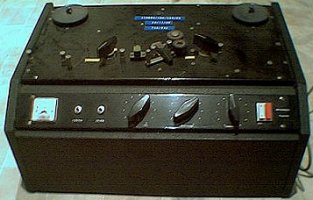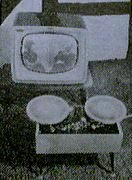The first attempt at a domestic "TV recorder" in the UK was Telcan, from the small Nottingham Electric Valve Company. It was a reel-to-reel system, which used ordinary 1/4 inch audio tape, recorded linearly with stationary heads. The high tape speed required by linear recording - 120 inches per second - meant that it could only manage a maximum of 20 minutes of low-resolution black and white recordings, though the tape could be turned over to get about 40 minutes per spool.
It was developed with cash from the powerful Granada TV company. Sydney Bernstein, the head of Granada, had met with NEVCo's Norman Rutherford and Michael Turner to see their "Mini-Eye" video camera, which was smaller and cheaper than the competition thanks to an innovatory design. But Bernstein found that the company was in no position to take a large order; Rutherford and Turner admitted that they needed £20,000 to get the company back into R&D. To their surprise Bernstein said that was "petty cash" and had a cheque written on the spot. They were then asked to turn their attention to a home television recorder, which was already being seen as the coming thing even in the early 1960s.
Initial experiments with modified audio tape recorders were not encouraging, but applying their creative genius to the design of a new recording head they managed to get the bandwidth up to 2.6MHz, high enough for reasonable quality - in fact it was nearly broadcast quality for the 405-line TV currently being broadcast. |
| Telcan was demonstrated in 1962, but curiously Granada were cool on it, and in fact pulled out of the company and sold their interest back to Rutherford and Turner. No explanation has ever been given for this. NEVCo managed to find new backers, and Telcan went on sale in 1963, with launch demonstrations to the public and on TV. It was mainly sold as a kit, for £60 [2005: £840], although pre-built units - including the "Combi" with the recorder mounted on top of a television - were also sold. |  |












